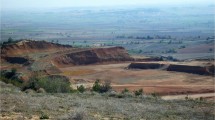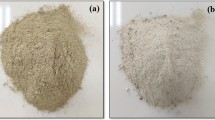Abstract
Unbalanced energy consumption in the production of ceramic artifacts is responsible for considerable undesirable impacts, such as increased emissions of polluting gases, excessive consumption of fuel materials, land degradation, and unpredictable financial costs. By contrast, the practice of optimizing the ceramic sintering, which in associated with firing of high temperature, can result in increased productivity and reduced production costs preserving an environmentally friendly production system. Moreover, it allows further improvements in the quality of the final product. This work compares the effect of different sintering cycles, with heating rates of 2, 15, and 30 °C/min, on the technological properties of a Brazilian industrial clay ceramic body. Initially the clay ceramic specimens were characterized in terms of mineralogical, chemical, and physical properties. Specimens were prepared by extrusion and fired at temperatures of 800, 900, and 1000 °C. The evaluated properties by standard tests were water absorption, post-firing linear shrinkage, and flexural strength. It was found that owing to sintering carried out at higher heating rates, red ceramic products with superior technological properties were obtained. This is an unprecedented conclusion for common clay ceramics produced in Brazil. Based on the promising obtained results, in a clear and detailed way, the benefits of rapid sintering cycle application for conventional brick production are evidenced.







Similar content being viewed by others
References
Bustamante GM, Bressiani JC (2000) Ceramic tile manufacturing technology. Cerâm Ind 5(3)
Alexandre J, Garcez de Azevedo AR, Xavier GDC, Pedroti LG, Vieira CMF, Monteiro SN (2014) Study of a clayey soil used in the fabrication of red ceramics in Campos Dos Goytacazes, Brazil. Mater Sci Forum 798–799:15–20. https://doi.org/10.4028/www.scientific.net/msf.798-799.15
National Association of Ceramic Industry (ANICER) (2020) Ann Rep 47
Brazilian Ministry of Mines and Energy (MME) (2021) Statistical yearbook: Non-metallic transformation sector. Secretariat of Geology, Mining and Mineral Transformation. Brasília 102
Vieira CMF, da Silva PRN, da Silva FT, Capitaneo JL, Monteiro SN (2005) Microstructural evaluation and properties of a ceramic body for extruded floor tile. Matéria 10(4):526–536 (In Portuguese)
Babisk MP, Amaral LF, Ribeiro LDS, Vieira CMF, do Prado US, Gadioli MCB, da Costa Garcia Filho F (2020) Evaluation and application of sintered red mud and its incorporated clay ceramics as materials for building construction. J Mater Res Technol 9:2186–95
Garcia-Valles M, Alfonso P, Martínez S, Roca N (2020) Mineralogical and thermal characterization of kaolinitic clays from Terra Alta (Catalonia, Spain). Minerals 10:142. https://doi.org/10.3390/min10020142
Silva AC, Méxas MP, Quelhas OLG (2017) Restrictive factors in implementation of clean technologies in red ceramic industries. J Clean Prod. https://doi.org/10.1016/j.jclepro.2017.09.086
Qin M, Tian Y, Hao H, Li Guomin Z, Y, Wu,Y, Bai P (2020) The effect of sintering temperature on phase evolution and sintering mechanism of ceramic proppants with CaCO3 addition. Mater Res. https://doi.org/10.1590/1980-5373-mr-2019-0602
Liu S, Guan X, Xu SZC, Li H, Zhang J (2017) Sintering red mud based imitative ceramic bricks with CO2 emissions below zero. Mater Lett. https://doi.org/10.1016/j.matlet.2016.12.028
Silva AC, Carolina SD, Sousa DN, Silva EMS (2019) Feldspar production from dimension stone tailings for application in the ceramic industry. J Market Res. https://doi.org/10.1016/j.jmrt.2018.02.011
Monteiro SN, Vieira CMF (2004) Solid state sintering of red ceramics at lower temperatures. Ceram Int 30:381–387. https://doi.org/10.1016/S0272-8842(03)00120-2
de Azevedo MC, Marvila MT, Delaqua GCG, Amaral LF, Colorado H, Vieira CMF (2021). Economy analysis of the implementation of extruded tiles fabrication in a ceramic industry containing ornamental rock waste. https://doi.org/10.1111/ijac.13728
Delaqua GCG, Marvila MT, Souza D, Rodriguez RSJ, Colorado HA, Vieira CMF (2020) Evaluation of the application of macrophyte biomass Salvinia auriculata Aublet in red ceramics. J Environ Manag 275:111253. https://doi.org/10.1016/j.jenvman.2020.111253
Ma X, Tian YM, Zhou Y, Wang KY, Chai YS, Li ZG (2016) Sintering temperature dependence of low-cost, low-density ceramic proppant with high breakage resistance. Mater Lett 180:127–129
Ma HQ, Tian YM, Zhou Y, Li GM, Wang KY (2018) Effective reduction of sintering temperature and breakage ratio for a low-cost ceramic proppant by feldspar addition. Int J Appl Ceram Technol 15:191–196
Cargnin M, Ulson de Souza SMAG, Ulson de Souza AA, de Noni A Jr (2015) Modeling and simulation of the effect of the firing curve on the linear shrinkage of ceramic materials: laboratory scale and industrial scale. Bra J Chem Eng 32(02):433–443. https://doi.org/10.1590/0104-6632.20150322s00002876
Salminen E, Mjöberg J, Anhava J (2019) Nordic ceramics industry best available technique (BAT). Copenhagen: Nordisk Ministerråd 81. https://doi.org/10.6027/TN2019-510
Kruth J-P, Leu MC, Nakagawa T (1998) Progress in additive manufacturing and rapid prototyping. Prog Addit Manuf Rapid Prototyp CIRP Ann 47:525–540. https://doi.org/10.1016/S0007-8506(07)63240-5
Azevedo ARG, França BR, Alexandre J, Marvila MT, Zanelato EB, Xavier EB (2018) Influence of sintering temperature of a ceramic substrate in mortar adhesion for civil construction. J Build Eng. https://doi.org/10.1016/j.jobe.2018.05.026
Vieira CMF, Sanchez R, Monteiro SN, Lalla N, Quaranta N (2013) Recycling of electric arc furnace dust into red ceramic. J Market Res. https://doi.org/10.1016/j.jmrt.2012.09.001
Amaral LF, Carvalho JPRG, Silva BM, Delaqua GCG, Monteiro SN, Vieira CMF (2019) Development of ceramic paver with ornamental rock waste. J Market Res. https://doi.org/10.1016/j.jmrt.2018.05.009
Monteiro SN, Vieira CMF (2004) Influence of firing temperature on the ceramic properties of clays from Campos dos Goytacazes, Brazil. Appl Clay Sci 27:229–234. https://doi.org/10.1016/j.clay.2004.03.002
Vieira CMF, Peçanha LA Jr, Monteiro SN (2006) Effect of kaolinitic clays from the State of Rio de Janeiro in the composition of whiteware floor tile bodies. Cerâmica 52:138–145 (In Portuguese)
Dondi M, Guarani I, Ligas GP, Palomba M, Raimondo M, Uras I (2010) Chemical, mineralogical and ceramic properties of kaolinitic materials from the Tresnuraghes mining district (Western Sardinia, Italy). Appl Clay Sci 18:145
Brazilian Association of Technical Standards (2016) ABNT (Associação Brasileira de Normas Técnicas). NBR 7181 - Soil - Grain size analysis. Rio de Janeiro: ABNT (In Portuguese)
Brazilian Association of Technical Standards (2017) ABNT (Associação Brasileira de Normas Técnicas). NBR 6459 - Soil - Liquid limit determination. Rio de Janeiro: ABNT (In Portuguese)
Brazilian Association of Technical Standards (2016) ABNT (Associação Brasileira de Normas Técnicas). NBR 7180 - Soil — Plasticity limit determination: ABNT (In Portuguese)
ASTM International (1997) Standard test methods for determination of water absorption and associated properties by vacuum method for pressed ceramic tiles and glass tiles and boil method for extruded ceramic tiles and non-tile fired ceramic whiteware products (Standard C373). In Annual Book of ASTM Standards
Johari I, Said S, Abu B, Bakar BH, Ahmad Z (2010) Effect of the change of firing temperature on microstructure and physical properties of clay bricks from Beruas (Malaysia). Sci Sinter 42. https://doi.org/10.2298/SOS1002245J
Vijayaragavan R, Mullainathan S (2011) Effect of sintering temperature on the properties and microstructure of a ceramic product. Mater Sci Res India 8(2):321–325. Available from: http://www.materialsciencejournal.org/?p=2668
Vieira CMF, Monteiro SN (2019) Firing behavior of the clay fraction of a natural kaolinitic clay: are they different? Mater Res 22. https://doi.org/10.1590/1980-5373-MR-2019-0172
Dondi M (2003) Technological characterization of clay materials: experimental methods and data interpretation. J Ceram Int 55–59
Heystek H (1964) Desired properties of clay minerals in ceramics. Am Ceram Soc Convent Chicago Abril
Marsigli M, Dondi M (1997) Plasticity of Italian clays for bricks and how they are expected to react during the shaping process. L’Industria dei Laterizi 46:214
Ribeiro MJ, Ferreira JM, Labrincha JA (2005) Plastic behaviour of different ceramic pastes processed by extrusion. Ceram Int 31(4):515–519. https://doi.org/10.1016/j.ceramint.2004.06.016
Dinger DR (2001) Particle calculations for ceramists. Morris Publishing, Kearney – NE, USA 126
Abubakar M, Muthuraja A, Rajak DK, Ahmad N, Pruncu CI, Lamberti L, Kumar A (2020) Influence of firing temperature on the physical, thermal and microstructural properties of Kankara Kaolin clay: a preliminary investigation. Materials 13:1872. https://doi.org/10.3390/ma13081872
Girondi GD, Marvila MM, de Azevedo ARG, de Souza CC, Souza D, de Brito J, Vieira CMF (2020) Recycling potential of powdered cigarette waste in the development of ceramic materials. J Mater Cycles Waste Manag 22(5):1672–1681
Nigay PM, Cutard T, Nzihou A (2017) The impact of heat treatment on the microstructure of a clay ceramic and its thermal and mechanical properties. Ceram Int 43:1747–1754. https://doi.org/10.1016/j.ceramint.2016.10.084
Liu K, Thomas G (1994) Time-temperature-transformation curves for kaolinite-α-alumina. J Am Ceram Soc. https://doi.org/10.1111/j.1151-2916.1994.tb09755.x
Behera PS, Bhattacharyya S (2020) Effect of different alumina sources on phase formation and densification of single-phase mullite ceramic – reference clay alumina system. Mater Today Commun 101818
Chen Y-F, Wang MC, Hon M-H (2004) Phase transformation and growth of mullite in kaolin ceramics. J Eur Ceram Soc 24:2389–2397. https://doi.org/10.1016/S0955-2219(03)00631-9
Navarro LCR, Menezes RR, Kiminami RHGA (2014) Microwave sintering of mullite-Al2O3 from kaolin precursor. Mater Res 17(6). https://doi.org/10.1590/1516-1439.281114
da Silva AGP, Schubert WD, Lux B (2001) The role of the binder phase in the WC-Co sintering. Mater Res 4(2). https://doi.org/10.1590/S1516-14392001000200003
Saleiro GT, Holanda JNF (2012) Processing of red ceramic using a fast-firing cycle. Cerâmica. https://doi.org/10.1590/S0366-69132012000300018(InPortuguese)
Santos ADCD, Skury ALD, Silva AGP (2017) Spark plasma sintering of a hard metal powder obtained from hard metal scrap. Mater Res 20:1980–5373. https://doi.org/10.1590/1980-5373-MR-2016-1035
Jones W, Miles LJ (1971) Production of β-Al2O3 electrolyte. Proc Brit Ceram Soc 19
Harmer MP, Brook RJ (1981) Fast firing-microstructural benefits. J Br Ceram Soc 80:147–148
Johnson DL, Kuczynski GC, Miller AE, Sargent GA (1984) Ultra-rapid sintering. Mater Sci Res 243
Zhang H, Xu Y, Wang B, Zhang X, Yang J, Niihara K (2015) Effects of heating rate on the microstructure and mechanical properties of rapid vacuum sintered translucent alumina. Ceram Int 41(9):12499–12503. https://doi.org/10.1016/j.ceramint.2015.05.136
Cokic SM, Vleugels J, Van Meerbeek B, Camargo B, Willems E, Li M, Zhang F (2020) Mechanical properties, aging stability and translucency of speed-sintered zirconia for chairside restorations. Dent Mater. https://doi.org/10.1016/j.dental.2020.04.026
Greskovich A, Lay KW (1972) Grain growth in very porous Al2O3 compacts. J Am Ceram Soc 55:142
Kim DH, Kim CH (1993) Effect of heating rate on pore shrinkage in yttria-doped zirconia. J Am Ceram Soc 76:1877
Palmeira AA, Cangani MP, Rodrigues D Jr, Strecker K, dos Santos C (2021) Influence of sintering parameters on the microstructure and mechanical properties of nanosized 3Y-TZP ceramics. Cerâmica 67:14–21. https://doi.org/10.1590/0366-69132021673812908(InPortuguese)
Castro RHR (2019) Controlling sintering and grain growth of nanoceramics. Cerâmica 65:122–129. https://doi.org/10.1590/0366-69132019653732573(InPortuguese)
Author information
Authors and Affiliations
Contributions
Carlos Alberto de Oliveira Guimarães and Sergio Neves Monteiro: methodology and investigation; Lucas Fonseca Amaral and Claudio Luiz Melo Souza: writing—original draft preparation and methodology; Angelus da Silva and José Nilson: methodology; Geovana Carla Delaqua: writing—review and editing; Afonso R. G. de Azevedo: writing—review and editing and supervision; Carlos Maurício Fontes Vieira and Sergio Neves Monteiro: supervision.
Corresponding author
Ethics declarations
Ethics approval
Not applicable.
Consent for publication
All authors consent to the publication of this manuscript.
Conflict of interest
The authors declare no competing interests.
Additional information
Publisher's note
Springer Nature remains neutral with regard to jurisdictional claims in published maps and institutional affiliations.
Rights and permissions
About this article
Cite this article
de Oliveira Guimarães, C.A., Delaqua, G.C.G., de Azevedo, A.R.G. et al. Heating rate effect during sintering on the technological properties of Brazilian red ceramics. Int J Adv Manuf Technol 119, 8125–8135 (2022). https://doi.org/10.1007/s00170-022-08793-1
Received:
Accepted:
Published:
Issue Date:
DOI: https://doi.org/10.1007/s00170-022-08793-1




